
Bible Verse and Prayer for Today;
O come, let us worship and bow down: let us kneel before the LORD our maker.
Psalm 95:6
Prayer
Lord . You are our Maker and Creator , You are the Giver of Everything Around Us . We want to Praise You , Exalt You with everything within Us and with everything we Have , Please accept our Humble Praise and Worship in Jesus name , Amen and Amen
Bybel Vers en Gebed vir Vandag
Kom, laat ons aanbid en neerbuig; laat ons kniel voor die HERE, ons Maker.
Psalm 95:6
Gebed
Here. U is ons Maker en Skepper, U is die Gewer van alles rondom ons. Ons wil U loof, U verhef met alles binne-in ons en met alles wat ons het. Aanvaar asseblief ons nederige lof en aanbidding in Jesus se naam, Amen en Amen.
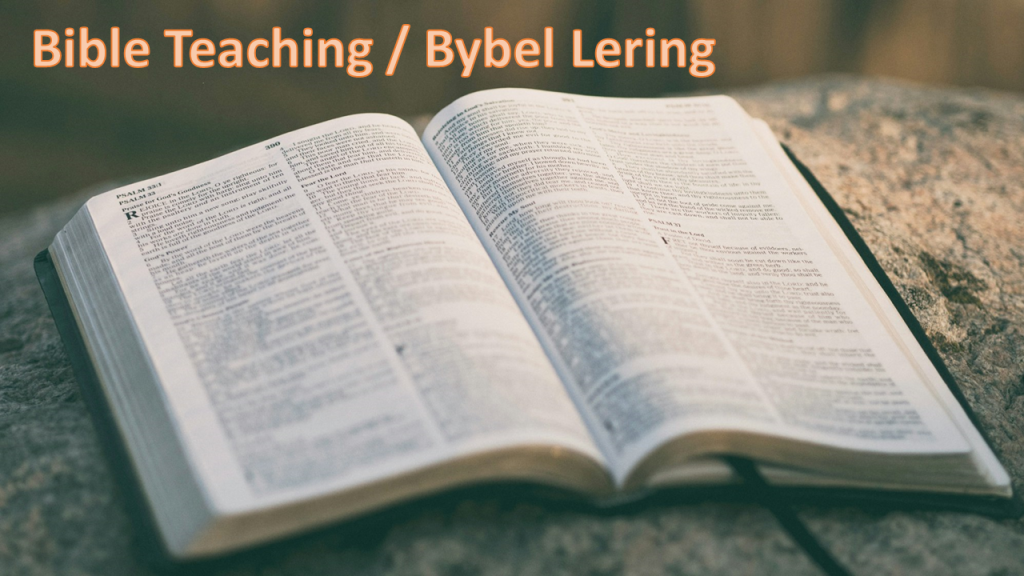
Bible Teaching of the Day
The coupling of grace and truth is found in numerous places in the Bible, including Colossians 1:6 and 2 John 1:3 in the New Testament, and 2 Samuel 15:20 and Psalm 86:15 in the Old Testament. Then there is John 1:14, 17, which says, “The Word became flesh and made his dwelling among us. We have seen his glory, the glory of the one and only Son, who came from the Father, full of grace and truth. . . . For the law was given through Moses; grace and truth came through Jesus Christ.”
There is a strong possibility that John is referencing the Hebrew terms hesed (“mercy” or “lovingkindness”) and emet (“truth” or “faithfulness”), found together in Exodus 34:6: “Then the Lord passed by in front of him and proclaimed, ‘The Lord, the Lord God, compassionate and gracious, slow to anger, and abounding in lovingkindness and truth.’” Note that the attributes of God in the Old Testament are applied to Christ in the New. At the beginning of his gospel, John is making a subtle statement regarding the divinity of Jesus. The rest of John’s gospel will expound on that truth.
It is important for grace and truth to work in tandem. An emphasis on grace alone can dissipate into a shallow and sentimental foundation where justice or truth is discarded. However, a focus only on truth can devolve into a cold, hardened dogma. Jesus’ character demonstrates the perfect balance of both grace and truth. He is “full” of both.
Grace and truth meld together in the gospel message to form a key distinction of Christianity over other religions. In all other religions, grace and truth are never balanced. Instead, the deity being worshiped either dispenses justice at the expense of grace or dispenses grace at the expense of justice and truth. Christianity is unique in that God delivers grace through His justice and truth.
The truth is, everyone has fallen short of the glory of God (Romans 3:23) and deserves God’s justice. However, God’s justice is satisfied, and His truth upheld, through the sacrifice of Jesus on the cross. That act delivers God’s grace to those who will accept it by faith.
In this way, Christianity stands alone as an ontological faith—one that is fully dependent on a person—Jesus Christ—who perfectly balances and embodies both grace and truth in His very being.
Bybel Lering vir die Dag
Die koppeling van genade en waarheid word op talle plekke in die Bybel gevind, insluitend Kolossense 1:6 en 2 Johannes 1:3 in die Nuwe Testament, en 2 Samuel 15:20 en Psalm 86:15 in die Ou Testament. Dan is daar Johannes 1:14, 17, wat sê: “Die Woord het vlees geword en onder ons gewoon. Ons het sy heerlikheid aanskou, die heerlikheid van die eniggebore Seun wat van die Vader gekom het, vol van genade en waarheid. … Want die wet is deur Moses gegee; die genade en die waarheid het deur Jesus Christus gekom.”
Daar is ‘n sterk moontlikheid dat Johannes verwys na die Hebreeuse terme hesed (“genade” of “liefdevolle goedhartigheid”) en emet (“waarheid” of “trouheid”), wat saam in Eksodus 34:6 gevind word: “Toe gaan die Here voor Hom verby en roep uit: ‘Die Here, die Here God, barmhartig en genadig, lankmoedig en vol liefdevolle goedhartigheid en waarheid.'” Let daarop dat die eienskappe van God in die Ou Testament op Christus in die Nuwe Testament toegepas word. Aan die begin van sy evangelie maak Johannes ‘n subtiele stelling oor die goddelikheid van Jesus. Die res van Johannes se evangelie sal op daardie waarheid uitbrei.
Dit is belangrik dat genade en waarheid saamwerk. ‘n Klem op genade alleen kan verdwyn in ‘n vlak en sentimentele fondament waar geregtigheid of waarheid verwerp word. ‘n Fokus slegs op waarheid kan egter in ‘n koue, verharde dogma ontaard. Jesus se karakter demonstreer die perfekte balans van beide genade en waarheid. Hy is “vol” van beide.
Genade en waarheid versmelt saam in die evangelieboodskap om ‘n sleutelonderskeid van die Christendom bo ander godsdienste te vorm. In alle ander godsdienste word genade en waarheid nooit gebalanseer nie. In plaas daarvan gee die godheid wat aanbid word, óf geregtigheid ten koste van genade, óf genade ten koste van geregtigheid en waarheid. Die Christendom is uniek deurdat God genade gee deur Sy geregtigheid en waarheid.
Die waarheid is dat almal tekortgeskiet het aan die heerlikheid van God (Romeine 3:23) en God se geregtigheid verdien. God se geregtigheid word egter bevredig en Sy waarheid gehandhaaf deur die offer van Jesus aan die kruis. Daardie daad gee God se genade aan diegene wat dit deur geloof sal aanvaar.
Op hierdie manier staan die Christendom alleen as ‘n ontologiese geloof – een wat ten volle afhanklik is van ‘n persoon – Jesus Christus – wat beide genade en waarheid perfek balanseer en beliggaam in Sy wese.
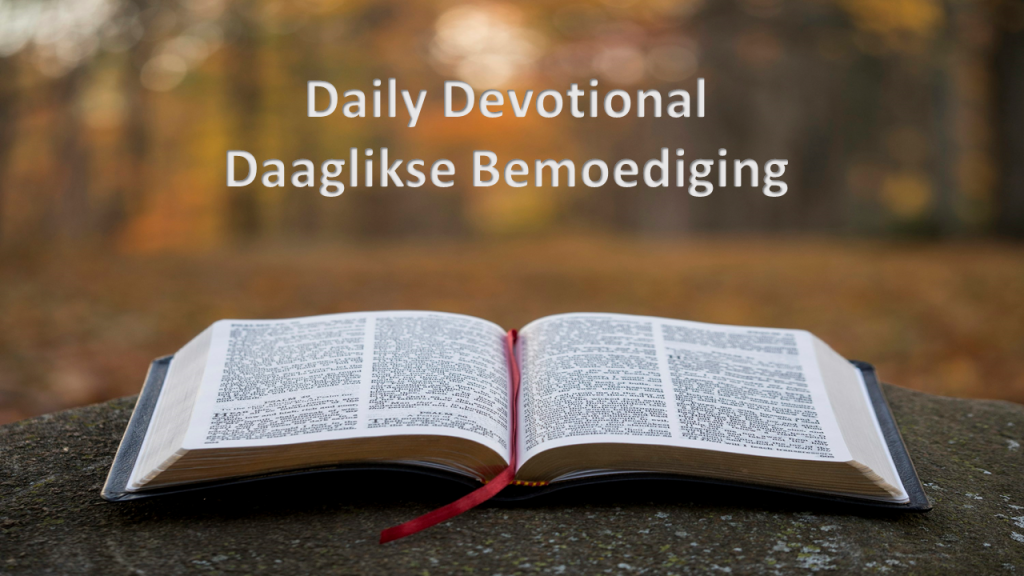
Today’s Devotional
Jesus gave His utmost to the Uttermost, by giving Himself to the least most.
Looking back at the 1st Quarter of 2025 and 2024, I ask myself, “Have I given my utmost to the Uttermost?” Somehow, I want to say that I did, but in all honesty, all I can say is that I have tried.
I’m convinced that we all can say, “I have tried” or “I have done my best.” If we’re honest, we all will acknowledge that we have failed in one area or another. Certainly, we all can look back and say we have fallen short but thank God for all that was done right and according to Gods will. Thank God for every person saved, encouraged, built up and helped by us, answering God’s call.
Today, at the end of May 2025, I want to thank every Giver and Donator of TruLight Ministries and their spouses and even their children for being playing their part in expanding the Kingdom of God.
I pray Numbers 6:24-26 over you and your household. May the LORD bless thee, and keep thee, make His face shine upon thee, and be gracious unto thee. May the LORD lift up his countenance upon thee, and give thee peace.
Your Gift or Donation to TruLight Ministries help us to reach the World with the Truth Gospel every minute of the Day. Thank You for Giving to the Lord!
Vandag se Bemoediging
Jesus het Sy uiterste aan die Alleruiterste gegee, deur Homself aan die minste en die meeste te gee.
As ek terugkyk na die eerste kwartaal van 2025 en 2024, vra ek myself af: “Het ek my uiterste aan die Alleruiterste gegee?” Op die een of ander manier wil ek sê dat ek dit gedoen het, maar in alle eerlikheid kan ek net sê dat ek probeer het.
Ek is oortuig dat ons almal kan sê: “Ek het probeer” of “Ek het my bes gedoen.” As ons eerlik is, sal ons almal erken dat ons op die een of ander gebied misluk het. Ons kan beslis almal terugkyk en sê dat ons tekortgeskiet het, maar dank God vir alles wat reg en volgens God se wil gedoen is. Dank God vir elke persoon wat deur ons gered, aangemoedig, opgebou en gehelp is, en God se roepstem beantwoord het.
Vandag, aan die einde van Mei 2025, wil ek elke Gewer en Skenker van TruLight Ministries en hul eggenote en selfs hul kinders bedank vir hul deelname aan die uitbreiding van die Koninkryk van God.
Ek bid Numeri 6:24-26 oor jou en jou huisgesin. Mag die HERE jou seën en jou behoed, sy aangesig oor jou laat skyn en jou genadig wees. Mag die HERE sy aangesig oor jou verhef en jou vrede gee.
Jou Geskenk of Donasie aan TruLight Ministries help ons om die Wêreld elke minuut van die Dag met die Waarheidsevangelie te bereik. Dankie dat jy aan die Here gee!

TruLight Ministries Daily Entertainment

TruLight TV – A Family Sing-Along with The Browders
Matthew 5:9 says, “Blessed are the peacemakers, for they will be called children of God.” Making peace is seldom easy, and there’s often a price to be paid. Watch today’s video to understand more about real peacemaking and how it points to life. After that, join Josh, Ashley, and their guest, The Browders, for a fun sing-along. The whole family gets involved, with father Tommy, brothers Matthew and David, and Matthew’s wife Sonya all taking turns singing. Sonya mentions that their music is for everyone, combining tunes from the past and present, so there’s something for all ages to enjoy. Have fun watching the show!
INTRODUCTION TO THE GOSPEL ARTISTS
MEET : THE STEELES

Today on TruLight Radio XM

TruLight Radio XM 24/7
Program
GMT / UTC +2
00:15 Words to Live By Testimonies
01.15 Science Scripture and Salvation
02.15 Ground Works
04.00 Gospel Concert of the Day
05.00 The Daren Streblow Comedy Show
5:55 It is Today devotional
6:00 Gaither Homecoming Morning Show
7:15 Discover the Word
8.15 Destined for Victory
8:55 Science Scripture and Salvation
9:00 Holy Spirit Hour – Normally Sermons
10:15 Hope of the Heart
11:15 Unshackled
11.45 Words to Live By
12:15 Truth for Life
13:15 Living on the Edge with Chip Ingram
14:15 Focus on the Family
15:00 Kids Hour
16:00 In Touch with Dr. Charles Stanley
16:30 Groundwork
17:15 Live in the Light
18:15 Renewing your Mind
19:00 Gaither Homecoming Show
20:15 Growing Hope
21:15 Adventures in Odyssey Radio Drama
21:45 Bible Reading
22:15 Night-sounds
23.00 Good Old Country Gospel / Rhema Gospel Express
VISIT THE WEBSITE
https://TruLightRadioXM.org.za
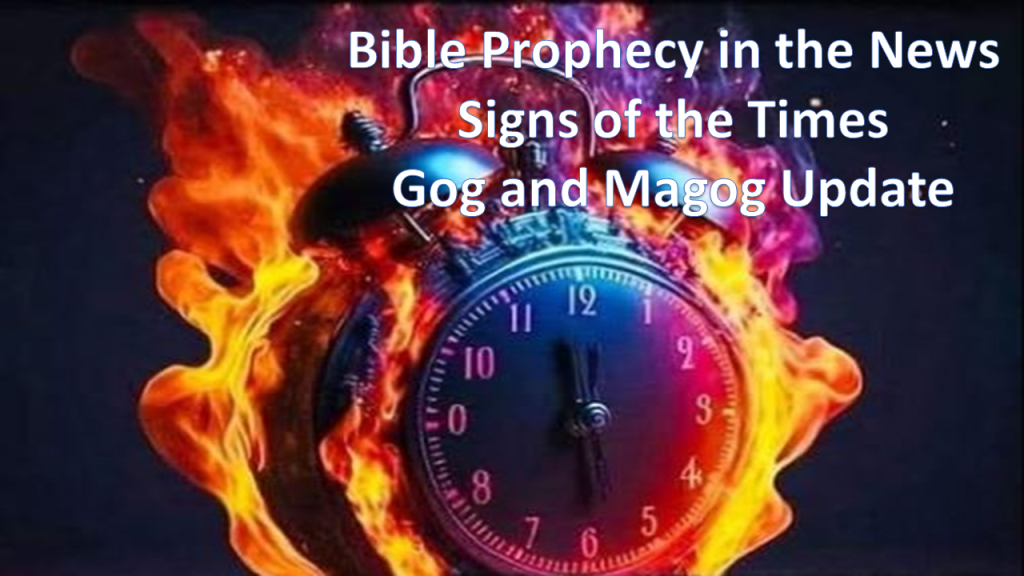
Bible Prophecy in the News
A Time of Genetic Corruption Is Here: Just Like The Days Of Noah

Even mainstream bioethicists warn that humanity is venturing into dangerous territory. Once we cross the line of germline editing (modifying DNA in ways that pass on to future generations), we are engaging in permanent alterations of the human species. This is not simply technological innovation–it is rebellion, a new form of genetic idolatry.
Mat 24:37 But as the days of Noe were, so shall also the coming of the Son of man be.
Mat 24:38 For as in the days that were before the flood they were eating and drinking, marrying and giving in marriage, until the day that Noe entered into the ark,
Mat 24:39 And knew not until the flood came, and took them all away; so shall also the coming of the Son of man be.
1 Peter 3:20 Which sometime were disobedient, when once the longsuffering of God waited in the days of Noah, while the ark was a preparing, wherein few, that is, eight souls were saved by water.
In Genesis 6, we read of a strange and disturbing time when “the sons of God came in to the daughters of men, and they bore children to them” (Genesis 6:4). These children were the Nephilim, mysterious hybrid beings who were “mighty men… men of renown.” While scholars debate the exact identity of the “sons of God,” my view is that they were fallen angels who transgressed their boundaries, resulting in a corrupted human race.
Jesus offered a chilling comparison in Matthew 24:37: “For the coming of the Son of Man will be just like the days of Noah.” This comparison begs a sobering question: If the world before the flood was marked by genetic corruption and hybrid entities, could we be heading toward a similar scenario today?
With CRISPR-Cas9, synthetic biology, and other advanced genetic engineering technologies at our fingertips, we are now able to manipulate DNA in ways unimaginable just decades ago. While these breakthroughs offer promising medical benefits, they also raise profound moral and theological concerns–especially when viewed through a prophetic lens.
The Days of Noah: A Time of Genetic Corruption
Genesis 6 describes not only extreme violence and wickedness, but also a profound corruption of human flesh:
“Then the LORD saw that the wickedness of man was great on the earth… and God looked on the earth, and behold, it was corrupt; for humanity had corrupted its way upon the earth” (Genesis 6:5, 12).
The Book of Enoch–though not canonical–shed more light on this corruption, describing how fallen angels taught humans forbidden knowledge, including weaponry, enchantments, astrology, and the manipulation of genetics. According to Enoch 7:2, the offspring of these unions were giants who “consumed all the acquisitions of men,” unleashing destruction upon the earth.
The flood wasn’t just about cleansing moral wickedness. It was also about preserving the integrity of God’s creation, especially the human genome. Noah is described as “blameless in his generations” (Genesis 6:9)–a phrase many believe refers to his uncontaminated lineage, not merely his moral character.
Jesus’ Warning: A Prophetic Parallel
When Jesus likens the Last Days to the “days of Noah,” He isn’t merely pointing to general wickedness or moral decay–though those are certainly present. He is referencing a time of spiritual and genetic rebellion, when boundaries between human and non-human were blurred.
Consider what we see today:
– Genetically modified embryos are being created and destroyed in laboratories.
– Human-animal chimeras are being developed for organ harvesting.
– Gene-editing technologies are being used to “enhance” human traits–raising the specter of designer babies, super soldiers, and possibly even post-human entities.
These developments raise a critical question: Are we opening a door once sealed by God after the flood? If the Nephilim were a product of angelic-human hybridization in Genesis 6, then our modern scientific pursuits may be ushering in a return of those hybrid beings–not through supernatural union, but through technological sorcery.
CRISPR and the Modern Tower of Babel
CRISPR-Cas9 is a gene-editing tool that allows scientists to cut and paste sections of DNA with extreme precision. While originally hailed as a cure for genetic diseases, CRISPR has quickly expanded into areas of genetic enhancement and embryonic modification. In 2018, Chinese scientist He Jiankui shocked the world by announcing the birth of the first CRISPR-edited babies, sparking an international outcry.
The Tower of Babel (Genesis 11) represents another moment when humanity attempted to transcend God-ordained boundaries. They sought to “make a name for ourselves” and reach the heavens through their own ingenuity. God responded by scattering them and confusing their languages. Today, mankind is once again reaching for godlike powers–this time not through bricks and towers, but through genes and machines.
“There is nothing that they purpose to do will be impossible for them” (Genesis 11:6b).
This verse takes on new meaning in the age of synthetic biology, where scientists talk openly about “playing God” and “creating life” in the lab. Like the men of Babel, we are seeking immortality and dominion without the Creator.
Hybrid Beings and Transhumanism: Echoes of the Nephilim?
The Nephilim were hybrids–part divine, part human. Today’s scientists envision a future of transhumans: beings who are part human, part machine, or genetically enhanced beyond what God intended. The transhumanist movement openly advocates for the next step in evolution–a post-human future where our biology is no longer a limitation but a canvas for re-creation.
Even secular voices are alarmed. Elon Musk has warned of the dangers of AI-human symbiosis, and Yuval Noah Harari has famously described humans as “hackable animals.” In his worldview, free will is an illusion and the future belongs to those who control the genome and the algorithm.
Could it be that we are re-creating the very conditions that led to the flood? Could hybrid beings return, not through angelic rebellion, but through technological apostasy?
The Spiritual War Behind the Science
Ephesians 6 reminds us that “we wrestle not against flesh and blood, but against principalities, against powers… against spiritual forces of wickedness in heavenly places” (Ephesians 6:12). Just as the Nephilim were not merely genetic anomalies, today’s bioengineering feats are not neutral, they are spiritually charged.
Satan has always sought to corrupt the image of God. In the garden, he tempted Eve with the promise that she could “be like God” (Genesis 3:5). In Genesis 6, he attempted to destroy the Messianic bloodline through hybridization. Now, in the modern age, he is inspiring a new generation of scientists to remake humanity in a counterfeit image.
Even mainstream bioethicists warn that humanity is venturing into dangerous territory. Once we cross the line of germline editing (modifying DNA in ways that pass on to future generations), we are engaging in permanent alterations of the human species.
This is not simply technological innovation–it is rebellion, a new form of genetic idolatry.
The Prophetic Implications
The book of Daniel says that in the Last Days, “knowledge will increase” (Daniel 12:4). Revelation describes a Beast system marked by global control, advanced image-making, and a mark that changes humanity’s destiny (Revelation 13:16-17).
Could the mark of the beast involve genetic manipulation? Some prophecy teachers speculate that it may include biometric or genetic encoding–something that alters not just one’s ability to buy or sell, but one’s very identity. If the Nephilim were irredeemable because they were no longer fully human, then it is possible that those who take the mark in the future could be permanently altered, disqualifying themselves from salvation (Revelation 14:9-11).
This fits with Satan’s strategy: to corrupt the image of God, replacing it with something hybridized, digitized, or mechanized. As in the days of Noah, humanity is being lured into a grand deception. A future where salvation is redefined and humanity is reengineered.
Redeeming the Narrative: A Call to Watch and Warn
Yet, we are not without hope. Jesus said, “When you see these things begin to happen, look up and lift up your heads, because your redemption is drawing near” (Luke 21:28). The rise of genetic manipulation is not only a sign of human arrogance–it is also a sign of prophetic acceleration. It tells us that the return of Christ is near.
As watchmen, we must sound the alarm. We must warn others that science without God becomes sorcery, that human enhancement without divine boundaries becomes rebellion, and that technology divorced from truth leads to deception.
We are called to notice the Nephilim spirit of this age–whether it comes in the form of fallen angels, genetic hybrids, or AI entities mimicking life. As Paul warned in 2 Thessalonians 2, a great deception is coming, one that will include lying signs and wonders. Our safeguard is the truth of God’s Word, our hope is in the return of Christ, and our strength is in the Holy Spirit.
Conclusion: Standing Firm in a Hybrid Age
The world is being prepared for a return to the days of Noah–where boundaries are erased, flesh is corrupted, and mankind is seduced by forbidden knowledge. We are not simply witnessing a scientific revolution. We are witnessing a spiritual reformation of evil.
The Nephilim of Genesis 6 were a warning. The words of Jesus in Matthew 24 are a reminder. And the prophecies of Revelation are a roadmap for what’s coming.
Let us watch. Let us warn. Let us hold fast to the truth in these final moments before the ark door closes again.
Signs of the Times
When Worship Loses The Word – The Dangerous Drift Of Progressive Praise

The kind of worship that’s emerging from progressive churches is not merely “different.” It’s dangerous. It offers a gospel without repentance, a kingdom without a King, and a worship that centers on human experience instead of divine revelation. It places feelings above faith, inclusion above instruction, and doubt above discipleship.
There’s a sobering line in the prophet Hosea that echoes with fresh urgency today: “My people are destroyed for lack of knowledge” (Hosea 4:6). It’s a warning to every generation that when we lose our grounding in the Word of God, we lose far more than clarity–we lose our very identity. Worship is not immune from this erosion. In fact, it may be the front line where the spiritual battle over truth is most quietly fought and dangerously lost.
A recent example of this drift comes from The Well Church in Gilbert, Arizona, which introduced a worship song that’s quickly making waves–not because of its beauty, but because of its bold embrace of theological confusion. The song’s catch phrase is “We’ve Got No Idea What We’re Doing,” and while the theme itself may be unintentionally honest, what follows is a troubling snapshot of what happens when worship untethers itself from biblical truth.
Here are some of the lyrics: God bless the Christian , God bless the atheist , God bless the Muslim , God bless the rest of us
https://www.instagram.com/reel/DJXBvfoOoNS
When Worship Replaces Revelation with Relativism
At first glance, this song might sound like a plea for unity, tolerance, or humility. But beneath the surface is a dangerous message: that truth is unknowable, doctrine is divisive, and everyone’s “spiritual truth” is equally valid. This is not humility–it’s heresy.
Let’s be clear. The Christian faith is not a foggy attempt to guess at God’s nature. It is the glorious revelation of God in Christ, who said, “I am the way, the truth, and the life. No one comes to the Father except through me” (John 14:6). The idea that “we’ve got no idea what we’re doing” when it comes to knowing and worshiping God directly contradicts Scripture, which declares that God has made Himself known through His Word, through His Son, and through the indwelling presence of the Holy Spirit.
The suggestion that all religions are equally valid paths to God is universalism–a belief soundly rejected by the historic, biblical faith. While we are called to love and pray for people of all backgrounds, it is not loving to pretend that truth is optional or that salvation can be found apart from Jesus Christ.
The Theology of Worship Matters
Worship is not meant to be a sentimental singalong. It is sacred space where we declare the truth of who God is, remember what He has done, and realign our hearts with His will. When worship is grounded in Scripture, it shapes our theology, renews our minds, and strengthens our faith. But when worship becomes theologically shallow or worse–contrary to God’s Word–it leads people away from truth under the guise of spiritual experience.
This is not a matter of musical taste. It’s not about hymns vs. choruses or organs vs. electric guitars. It’s about content. A song that says “God bless the atheist” in the same breath as “God bless the Christian” is not offering a prayer–it’s erasing the reality of sin, repentance, and the gospel. And to sing “We’ve got no idea what we’re doing” as a refrain of supposed unity is to confess not humility, but surrender–to the spirit of the age rather than the Spirit of God.
The Progressive Gospel Isn’t the Gospel
The kind of worship that’s emerging from progressive churches like The Well is not merely “different.” It’s dangerous. It offers a gospel without repentance, a kingdom without a King, and a worship that centers on human experience instead of divine revelation. It places feelings above faith, inclusion above instruction, and doubt above discipleship.
Ironically, the only truthful line in the entire song may be its title. “We’ve got no idea what we’re doing” is exactly what happens when churches abandon Scripture as their authority and trade theological literacy for emotional expression. It’s the tragic theme song of a movement that wants the warmth of worship without the fire of truth.
But friends, we are not a people left in the dark. We are not wandering without a map. “Your Word is a lamp to my feet and a light to my path” (Psalm 119:105). God has not left us guessing. He has spoken. He has come. And He is worthy of worship that reflects the fullness of His truth and glory.
A Call to Clarity in Worship
As worship leaders, songwriters, and pastors, we must be vigilant. Theology matters. Lyrics shape belief. Our songs should echo Scripture, not contradict it. They should lead us to the cross, not away from it. We must resist the temptation to trade clarity for cultural acceptance and be willing to speak–and sing–the truth in love.
Let this be a wake-up call to the Church. Worship is not the place to “figure it out” or blend belief systems. It’s the place to proclaim the God who has already revealed Himself. And as for those singing songs of confusion? The most truthful lyric may be the most tragic: “We’ve got no idea what we’re doing.”
Let’s write and sing songs that show we do.
Places in the Bible
Magdala
Also known as Mejdel, el-Majdal, Magadan, Majdal, Mejdel, Taricheae
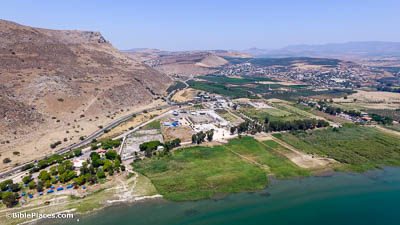
An Important Fishing Center
Magdala was also known as Taricheae, according to Josephus, which indicates that it was an important fishing center (Life, 72). Strabo also referred to the importance of the salted fish industry: “At the place called Taricheae the lake supplies excellent fish for pickling” (16.2.45). Josephus referred to Magdala as one of the two main administrative centers in the region, along with Tiberias. The rabbis criticized the immorality of the residents. This photo shows the area of the ancient site from the southeast.
Marketplace and Synagogue
The fishing village of Magdala is never explicitly mentioned in Scripture, but Mary Magdalene, “from whom seven demons had come out,” was from Magdala (Luke 8:2). Matthew 15:39 calls the village Magadan. The region of Dalmanutha (Mark 8:10) is apparently equivalent to the “region of Magadan” (Matt 15:39). Though not mentioned explicitly as a place that Jesus visited, Magdala was probably included in the references to Jesus’s travel to “nearby villages” (Mark 1:38-39; Luke 4:43; Matt 4:23), and “every village” (Luke 5:17).
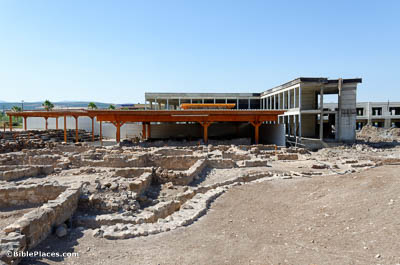
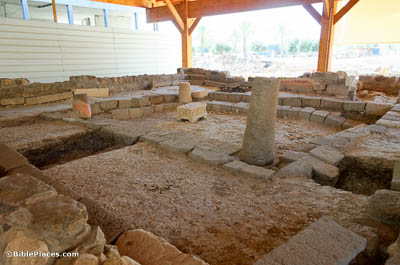
First-Century Synagogue
The city of Magdala was originally excavated by the Franciscans from 1971 to 1973. A new wave of excavations began in 2006 and is ongoing. Excavators, working in advance of the construction of a tourist center, discovered a synagogue at Magdala in 2009. This synagogue is said to date from the Second Temple period (50 BC to AD 100), contemporary with the time of Jesus’s ministry and His healing of Mary Magdalene. It was the first synagogue of its period to be found at a Galilean site. More recent excavations have discovered a second synagogue from the time of Jesus.
Ornamented Table in the Synagogue
A unique feature of this synagogue was a decorated stone inscribed with a seven-branched menorah. According to the excavation director, Dina Avshalom-Gorni, “This is the first time that a menorah decoration has been discovered from the days when the Second Temple was still standing. This is the first menorah to be discovered in a Jewish context and that dates to the Second Temple period/beginning of the Early Roman period.” This depiction of a menorah lends evidence to the belief that, even in the Second Temple period, there was some symbolic connection between synagogues and the temple.
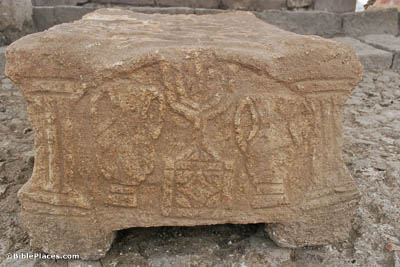
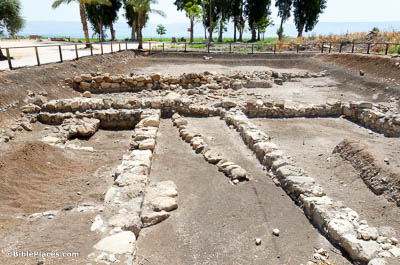
Magdala’s Ancient Port
Josephus wrote that the town had many boats, shipyard workers, and wood supplies. He reported that he brought 230 boats from Migdal to Tiberias. The Franciscan excavators, however, used the harbor as a dump, not realizing its significance. The harbor is composed of two parts: the promenade and the sheltered basin. A mooring stone has been found at the western end of the harbor. The breakwater is 20 feet (6 m) wide and 230 feet (69 m) long, and the foundations are made of basalt and limestone boulders. The basin covers one acre (0.4 ha) and has a quay.
TruLight Ministry News

TruLight Ministries orders from God since 2012 . Teach Them , Comfort Them and Warn Them!
////////////
TruLight Ministries opdrag vanaf God sedert 2012. Leer hulle, Troos hulle en Waarsku hulle!
Pastoor Dirk se Audio Lering 8/8 Laaste 8 Jaar op Aarde – Studie 8 : Hy Het weer Gekom
TruLight School of Theology have started with Its daily Bible Study – Pastor Counselling Certificate – we are Starting with 36 Studies with 10 Studies per Topic from 1st of April 2025 – Over the Next 2 Years we will Include One Daily Study per Topic on this Platform. The Daily Manna Bible Study will be Available in English and Afrikaans!
We will Start with a 68 week Study on “Know Your Bible” Daily Bible Summaries of every Chapter in the Bible! From the Old Testament to the New Testament , from Genesis to Revelation 66 Books of the Bible.
Started 1st April 2025
This is our Study Principals:
SOAP
Scripture: Read a short passage out loud.
Observation: What do you notice about the verses?.
Application: How can you apply this to your life?.
Prayer: Pray about what you’ve learned.
REAP
Read: Read the passage carefully.
Engage: Ask questions about the passage.
Apply: Think about how the passage applies to your life.
Pray: Pray about what you’ve learned.
Introduction to the Bible – Bible Summary
New Testament Survey
The New Testament is divided into five sections: the Gospels (Matthew through John),
history (the book of Acts), the Pauline Epistles (Romans through Philemon), the General
Epistles (Hebrews through Jude), and prophecy (the book of Revelation). The New
Testament was written from approximately A.D. 45 to approximately A.D. 95. The New
Testament was written in Koine Greek (common Greek, the everyday form of the Greek
language in the first century A.D.)
The Gospels give us four different, yet not conflicting, accounts of the birth, life, ministry,
death, and resurrection of Jesus Christ. The Gospels demonstrate how Jesus was the
promised Messiah of the Old Testament and lay the foundation for the teaching of the
rest of the New Testament. The book of Acts records the deeds of Jesus’ apostles, the
men Jesus sent out into the world to proclaim the Gospel of salvation. Acts tells us of
the beginning of the church and its rapid growth in the first century A.D. The Pauline
Epistles, written by the Apostle Paul, are letters to specific churches – giving official
Christian doctrine and the practice that should follow that doctrine. The General Epistles
compliment the Pauline Epistles with additional teaching and application. The book of
Revelation prophesies the events that will occur in the end times.
A survey of the New Testament is a powerful and rewarding study. The New Testament
tells us of Jesus’ death on the cross on our behalf – and what our response should be to
His death. The New Testament focuses on giving solid Christian teaching along with the
practical results that should follow that teaching. Below are links to summaries of the
various books of the New Testament. We sincerely hope you find our New Testament
Survey beneficial in your walk with Christ.
Summary of the Gospel of
Matthew
Author: This book is known as the Gospel of Matthew because it was written by the
apostle of the same name. The style of the book is exactly what would be expected of a
man who was once a tax collector. Matthew has a keen interest in accounting (18:23-24;
25:14-15). The Gospel of Matthew is very orderly and concise. Rather than write in
chronological order, Matthew arranges this Gospel through six discussions.
As a tax collector, Matthew possessed a skill that makes his writing all the more exciting
for Christians. Tax collectors were expected to be able to write in a form of shorthand,
which essentially meant that Matthew could record a person’s words as they spoke,
word for word. This ability means that the words of Matthew are not only inspired by
the Holy Spirit, but should represent an actual transcript of some of Christ’s sermons.
For example, the Sermon on the Mount, as recorded in chapters 5-7, is almost certainly
a perfect recording of that great message. Full article: Who wrote the book of Matthew?
Who was the author of Matthew?
Date of Writing: As an apostle, Matthew wrote the Gospel of Matthew in the early
period of the church, probably in A.D. 55-65. This was a time when most Christians were
Jewish converts, so Matthew’s focus on Jewish perspective in this Gospel is
understandable.
Purpose of Writing: Matthew intends to prove to the Jews that Jesus Christ is the
promised Messiah. More than any other Gospel, the Gospel of Matthew quotes the Old
Testament to show how Jesus fulfilled the words of the Jewish prophets. Matthew
describes in detail the lineage of Jesus from David, and uses many forms of speech that
Jews would have been comfortable with. Matthew’s love and concern for his people is
apparent through his meticulous approach to telling the gospel story.
Key Verses:
Matthew 5:17: “Do not think that I have come to abolish the Law or the Prophets; I have
not come to abolish them but to fulfill them.”
Matthew 5:43-44: “You have heard that it was said, ‘Love your neighbor and hate your
enemy.’ But I tell you: Love your enemies and pray for those who persecute you.”
Matthew 6:9-13: “This, then, is how you should pray: ‘Our Father in heaven, hallowed be
your name, your kingdom come, your will be done on earth as it is in heaven. Give us
today our daily bread. Forgive us our debts, as we also have forgiven our debtors. And
lead us not into temptation, but deliver us from the evil one.”
Matthew 16:26: “What good will it be for a man if he gains the whole world, yet forfeits
his soul? Or what can a man give in exchange for his soul?”
Matthew 22:37-40: “Jesus replied, ‘”Love the Lord your God with all your heart and with
all your soul and with all your mind.” This is the first and greatest commandment. And
the second is like it: “Love your neighbor as yourself.” All the Law and the Prophets hang
on these two.'”
Matthew 27:31: “After they had mocked him, they took off the robe and put his own
clothes on him. Then they led him away to crucify him.”
Matthew 28:5-6: “The angel said to the women, ‘Do not be afraid, for I know that you
are looking for Jesus, who was crucified. He is not here; he has risen, just as he said.
Come and see the place where he lay.’”
Matthew 28:19-20: “Therefore go and make disciples of all nations, baptizing them in
the name of the Father and of the Son and of the Holy Spirit, and teaching them to obey
everything I have commanded you. And surely I am with you always, to the very end of
the age.”
Brief Summary: The Gospel of Matthew discusses the lineage, birth, and early life of
Christ in the first two chapters. From there, the book discusses the ministry of Jesus. The
descriptions of Christ’s teachings are arranged around “discourses” such as the Sermon
on the Mount in chapters 5 through 7. Chapter 10 involves the mission and purpose of
the disciples; chapter 13 is a collection of parables; chapter 18 discusses the church;
chapter 23 begins a discourse about hypocrisy and the future. Chapters 21 through 27
discuss the arrest, torture, and execution of Jesus. The final chapter describes the
Resurrection and the Great Commission.
Connections: Because Matthew’s purpose is to present Jesus Christ as the King and
Messiah of Israel, he quotes from the Old Testament more than any of the other three
Gospel writers. Matthew quotes more than 60 times from prophetic passages of the Old
Testament, demonstrating how Jesus fulfilled them. He begins his Gospel with the
genealogy of Jesus, tracing Him back to Abraham, the progenitor of the Jews. From
there, Matthew quotes extensively from the prophets, frequently using the phrase “as
was spoken through the prophet(s)” (Matthew 1:22-23, 2:5-6, 2:15, 4:13-16, 8:16-
17, 13:35, 21:4-5). These verses refer to the Old Testament prophecies of His virgin birth
(Isaiah 7:14) in Bethlehem (Micah 5:2), His return from Egypt after the death of Herod
(Hosea 11:1), His ministry to the Gentiles (Isaiah 9:1-2; 60:1-3), His miraculous healings
of both body and soul (Isaiah 53:4), His speaking in parables (Psalm 78:2), and His
triumphal entry into Jerusalem (Zechariah 9:9).
Practical Application: The Gospel of Matthew is an excellent introduction to the core
teachings of Christianity. The logical outline style makes it easy to locate discussions of
various topics. Matthew is especially useful for understanding how the life of Christ was
the fulfillment of the Old Testament prophecies.
Matthew’s intended audience was his fellow Jews, many of whom—especially the
Pharisees and Sadducees—stubbornly refused to accept Jesus as their Messiah. In spite
of centuries of reading and studying the Old Testament, their eyes were blinded to the
truth of who Jesus was. Jesus rebuked them for their hard hearts and their refusal to
recognize the One they had supposedly been waiting for (John 5:38-40). They wanted a
Messiah on their own terms, one who would fulfill their own desires and do what they
wanted Him to do. How often do we seek God on our own terms? Don’t we reject Him
by ascribing to Him only those attributes we find acceptable, the ones that make us feel
good—His love, mercy, grace—while rejecting those we find objectionable—His wrath,
justice, and holy anger? We dare not make the mistake of the Pharisees, creating God in
our own image and then expecting Him to live up to our standards. Such a god is
nothing more than an idol. The Bible gives us more than enough information about the
true nature and identity of God and Jesus Christ to warrant our worship and our
obedience.
Inleiding tot die Bybel – Bybel Samevatting
Nuwe Testament Samevatting
Die Nuwe Testament is in vyf afdelings verdeel: die Evangelies (Matteus tot Johannes),
geskiedenis (die boek Handelinge), die Pauliniese Briewe (Romeine tot Filemon), die
Algemene Briewe (Hebreërs tot Judas) en profesie (die boek Openbaring). ). Die Nuwe
Testament is geskryf vanaf ongeveer 45 nC tot ongeveer 95 nC. Die Nuwe Testament is
in Koine Grieks geskryf (gewone Grieks, die alledaagse vorm van die Griekse taal in die
eerste eeu nC)
Die Evangelies gee vir ons vier verskillende, maar nie teenstrydige nie, verslae van die
geboorte, lewe, bediening, dood en opstanding van Jesus Christus. Die Evangelies
demonstreer hoe Jesus die beloofde Messias van die Ou Testament was en lê die
grondslag vir die leer van die res van die Nuwe Testament. Die boek Handelinge beskryf
die dade van Jesus se apostels, die manne wat Jesus na die wêreld gestuur het om die
Evangelie van verlossing te verkondig. Handelinge vertel ons van die begin van die kerk
en sy vinnige groei in die eerste eeu nC. Die Pauliniese briewe, geskryf deur die apostel
Paulus, is briewe aan spesifieke kerke – wat amptelike Christelike leerstellings gee en die
praktyk wat daardie leerstelling moet volg. Die Algemene Briewe komplimenteer die
Pauliniese Briewe met bykomende onderrig en toepassing. Die boek Openbaring
profeteer die gebeure wat in die eindtyd sal plaasvind.
‘n Oorsig van die Nuwe Testament is ‘n kragtige en lonende studie. Die Nuwe Testament
vertel ons van Jesus se kruisdood namens ons – en wat ons reaksie op Sy dood moet
wees. Die Nuwe Testament fokus daarop om soliede Christelike lering te gee tesame
met die praktiese resultate wat op daardie lering behoort te volg. Hieronder is skakels
na opsommings van die verskillende boeke van die Nuwe Testament. Ons hoop van
harte dat u ons Nuwe-Testamentiese opname nuttig vind in u wandel met Christus.
Opsomming van die Evangelie
van Matteus
Skrywer: Hierdie boek staan bekend as die Evangelie van Matteus omdat dit deur die
gelyknamige apostel geskryf is. Die styl van die boek is presies wat verwag sou word van
‘n man wat eens ‘n tollenaar was. Matteus het ‘n groot belangstelling in rekeningkunde
(18:23-24; 25:14-15). Die Matteus-evangelie is baie ordelik en bondig. Eerder as om in
chronologiese volgorde te skryf, rangskik Matteus hierdie Evangelie deur ses
besprekings.
As ‘n tollenaar het Matteus ‘n vaardigheid gehad wat sy skryfwerk vir Christene des te
meer opwindend maak. Daar is van belastinggaarders verwag om in ‘n vorm van
snelskrif te kon skryf, wat in wese beteken het dat Matthew ‘n persoon se woorde kon
opteken terwyl hulle praat, woord vir woord. Hierdie vermoë beteken dat die woorde
van Matteus nie net deur die Heilige Gees geïnspireer is nie, maar ‘n werklike
transkripsie van sommige van Christus se preke moet verteenwoordig. Byvoorbeeld, die
Bergpredikasie, soos opgeteken in hoofstukke 5-7, is byna seker ‘n perfekte optekening
van daardie groot boodskap. Volledige artikel: Wie het die boek Matteus geskryf? Wie
was die skrywer van Matteus?
Datum van Skrywe: As ‘n apostel het Matteus die Evangelie van Matteus geskryf in die
vroeë tydperk van die kerk, waarskynlik in 55-65 nC. Dit was ‘n tyd toe die meeste
Christene Joodse bekeerlinge was, so Matteus se fokus op Joodse perspektief in hierdie
Evangelie is verstaanbaar.
Doel van die skrywe: Matteus beoog om aan die Jode te bewys dat Jesus Christus die
beloofde Messias is. Meer as enige ander Evangelie haal die Evangelie van Matteus die
Ou Testament aan om te wys hoe Jesus die woorde van die Joodse profete vervul het.
Matteus beskryf in detail die afkoms van Jesus vanaf Dawid, en gebruik baie vorme van
spraak waarmee Jode gemaklik sou gewees het. Matteus se liefde en omgee vir sy
mense is duidelik deur sy noukeurige benadering tot die vertel van die evangelieverhaal.
Sleutelverse:
Matteus 5:17 : “Moenie dink dat Ek gekom het om die wet of die profete te ontbind nie;
Ek het nie gekom om hulle tot niet te maak nie, maar om hulle te vervul.”
Matteus 5:43-44 : “Julle het gehoor dat daar gesê is: Jy moet jou naaste liefhê en jou
vyand haat. Maar Ek sê vir julle: Julle moet julle vyande liefhê en bid vir die wat julle
vervolg.”
Matteus 6:9-13 : “So moet julle dan bid: Onse Vader wat in die hemele is, laat u Naam
geheilig word, laat u koninkryk kom; laat u wil ook op die aarde geskied, net soos in die
hemel. Gee ons vandag ons daaglikse brood. Vergeef ons ons skulde, soos ons ook ons
skuldenaars vergewe het. En lei ons nie in versoeking nie, maar verlos ons van die Bose.”
Matteus 16:26 : “Wat baat dit vir ’n mens as hy die hele wêreld win, maar tog sy siel
verbeur? Of wat kan ‘n mens gee in ruil vir sy siel?”
Matteus 22:37-40 : “Jesus het geantwoord: “Jy moet die Here jou God liefhê met jou
hele hart en met jou hele siel en met jou hele verstand.” Dit is die eerste en grootste
gebod. En die tweede is soos dit: ” Jy moet jou naaste liefhê soos jouself.” Aan hierdie
twee hang die hele wet en die profete.”
Matteus 27:31 : “Nadat hulle met hom gespot het, het hulle die kleed uitgetrek en hom
sy eie klere aangetrek. Toe het hulle Hom weggelei om Hom te kruisig.”
Matteus 28:5-6 : “Die engel sê vir die vroue: Moenie bang wees nie, want ek weet dat
julle Jesus soek wat gekruisig is. Hy is nie hier nie; hy het opgestaan, net soos hy gesê
het. Kom kyk na die plek waar Hy gelê het.”
Matteus 28:19-20 : “Gaan dan heen, maak dissipels van al die nasies, en doop hulle in
die Naam van die Vader en die Seun en die Heilige Gees, en leer hulle om gehoorsaam
alles wat Ek jou beveel het. En Ek is sekerlik altyd by julle tot aan die voleinding van die
wêreld.”
Kort opsomming: Die Evangelie van Matteus bespreek die afkoms, geboorte en vroeë
lewe van Christus in die eerste twee hoofstukke. Van daar af bespreek die boek die
bediening van Jesus. Die beskrywings van Christus se leringe is gerangskik rondom
“diskoerse” soos die Bergpredikasie in hoofstukke 5 tot 7. Hoofstuk 10 behels die missie
en doel van die dissipels; hoofstuk 13 is ‘n versameling gelykenisse; hoofstuk 18
bespreek die kerk; hoofstuk 23 begin ‘n diskoers oor skynheiligheid en die toekoms.
Hoofstukke 21 tot 27 bespreek die arrestasie, marteling en teregstelling van Jesus. Die
laaste hoofstuk beskryf die Opstanding en die Groot Opdrag.
Verbindings: Omdat Matteus se doel is om Jesus Christus as die Koning en Messias van
Israel voor te hou, haal hy meer uit die Ou Testament aan as enige van die ander drie
Evangelieskrywers. Matteus haal meer as 60 keer aan uit profetiese gedeeltes van die Ou
Testament, wat demonstreer hoe Jesus dit vervul het. Hy begin sy Evangelie met die
geslagsregister van Jesus, en spoor Hom terug na Abraham, die stamvader van die Jode.
Van daar haal Matteus breedvoerig uit die profete aan en gebruik gereeld die frase
“soos deur die profeet(s) gespreek is” ( Matteus 1:22-23 , 2:5-6 , 2:15 , 4:13-16 , 8) :16-17
, 13:35 , 21:4-5 ). Hierdie verse verwys na die Ou Testamentiese profesieë van Sy
maagdelike geboorte ( Jesaja 7:14 ) in Betlehem ( Miga 5:2 ), Sy terugkeer uit Egipte na
die dood van Herodes ( Hoséa 11:1 ), Sy bediening aan die heidene ( Jesaja) 9:1-2 ; 60:1-
3 ), Sy wonderdadige genesings van beide liggaam en siel ( Jesaja 53:4 ), Sy spreek in
gelykenisse ( Ps. 78:2 ), en Sy triomfantelike intog in Jerusalem ( Sagaria 9:9) ).
Praktiese toepassing: Die Evangelie van Matteus is ‘n uitstekende inleiding tot die
kernleerstellings van die Christendom. Die logiese uiteensettingstyl maak dit maklik om
besprekings van verskeie onderwerpe op te spoor. Matteus is veral nuttig om te
verstaan hoe die lewe van Christus die vervulling van die Ou Testamentiese profesieë
was.
Matteus se voorgenome gehoor was sy mede-Jode, van wie baie – veral die Fariseërs en
Sadduseërs – hardnekkig geweier het om Jesus as hulle Messias te aanvaar. Ten spyte
van eeue se lees en bestudering van die Ou Testament, was hulle oë verblind vir die
waarheid van wie Jesus was. Jesus het hulle bestraf oor hul harde harte en hul weiering
om die Een te erken waarvoor hulle kwansuis gewag het ( Joh. 5:38-40 ). Hulle wou ‘n
Messias op hul eie voorwaardes hê, een wat hul eie begeertes sou vervul en doen wat
hulle wou hê Hy moes doen. Hoe dikwels soek ons God op ons eie terme? Verwerp ons
Hom nie deur net daardie eienskappe aan Hom toe te skryf wat ons aanvaarbaar vind
nie, die wat ons laat goed voel—Sy liefde, barmhartigheid, genade—terwyl ons diegene
wat ons aanstootlik vind—Sy toorn, geregtigheid en heilige woede verwerp nie? Ons
durf nie die fout van die Fariseërs maak om God na ons eie beeld te skep en dan van
Hom te verwag om aan ons standaarde te voldoen nie. So ‘n god is niks meer as ‘n
afgod nie. Die Bybel gee ons meer as genoeg inligting oor die ware aard en identiteit
van God en Jesus Christus om ons aanbidding en ons gehoorsaamheid te regverdig.
We are Currently reading and Listening to the Bible, a Chapter a Day !
The total number of chapters in the Bible is 1,189. There are 929 chapters within 39 books of the Old Testament and 260 chapters within the 27 books of the New Testament.
Genesis 42 / 43 English – Follow the Reading in Your Bible.
Genesis 42 / 43 Afrikaans – Volg die Leser in u Bybel.
Something New Coming June 2025 to this APP

Healing Articles Coming soon
Share this Feeding of Manna with your Friends and Family. just click on the Social Media icon and share !